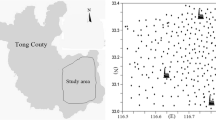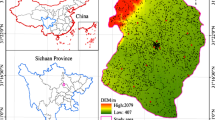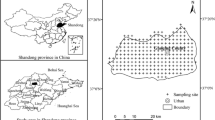Abstract
To accurately visualize the spatial distribution of heavy metal pollution and provide information that assists in remediating farmland soil, this study employed GIS technology and collected 0–20 cm-depth surface soil and shallow groundwater samples from farmland in Jianxin Village, Xiba Town, Wutongqiao City, Sichuan Province, China. The soil samples were decomposed using a high-temperature closed digestion method, and the contents of Cr, Cd, Pb, As, Cu and Zn were determined using ICP-MS. A geographic semi-variogram analysis was then conducted to delineate spatial variations in the heavy metal concentrations within the soil, and a spatial distribution map of heavy metals in the soil was drawn using ArcGIS10.2 software based on a GIS Kriging interpolation spatial structure analysis. The results showed that all heavy metal element concentrations exceeded the soil background values of Sichuan Province; the exceeded rates of Cr, Cd, and Zn were 100%. All Cd samples exceeded the soil baseline value, and the pollution accumulation of Cr, Cd, and Zn was determined as being serious. Through a comparison of cross-validation methods, a theoretical optimal semi-variogram model of six heavy metal elements was obtained. Indexes C0/(C0 + C) of Cd, Pb, As, Cu, and Zn were in the range of 48–75%, which showed that their contents related to structural factors, such as the soil parent material and topography, and also to non-structural factors such as human activities. The index C0/(C0 + C) of Cr was more than 75%, which indicates that its content is mainly related to non-structural factors and human activities. The spatial correlation followed the order of Cu > Cd > Pb > Zn > As > Cr. The vertical distribution of heavy metals was greatly affected by the soil physical properties: the Cu and Pb contents of sandy soil decreased at first and then increased with depth; the Cr, Zn, and As contents first increased and then decreased with depth; and the Cd contents decreased with depth. In clay soil, there was little change in the Cu content with depth; the Cd, Zn, Pb, and As contents first decreased and then increased with depth, and the Cr content increased first and then decreased with depth. These results show that visualizing the spatial distribution of heavy metal contamination using GIS technology is significant for providing information that can be used to remediate farmland soil.














Similar content being viewed by others
References
Ali SA, Khatun R, Ahmad A, Ahmad SN (2020) Assessment of cyclone vulnerability, hazard evaluation and mitigation capacity for analyzing cyclone risk using gis technique: a study on sundarban biosphere reserve, india. Earth Syst Environ 4:71–92. https://doi.org/10.1007/s41748-019-00140-x
Alkindi KM, Alkharusi A, Alshukaili D, Alnasiri N, Kenawy A, Talal A, Yassine C, Ahmed EM (2020) Spatiotemporal assessment of COVID-19 spread over Oman using GIS techniques. Earth Syst Environ 4:797–811. https://doi.org/10.1007/s41748-020-00194-2
Anderson A (1977) Heavy metals in Swedish soils: on their retention, distribution and amounts. Swed J Agric Res 7:7–20
Boubehziz S, Khanchoul K, Benslama M, Benslama A, Marchetti A, Francaviglia R, Piccini C (2020) Predictive mapping of soil organic carbon in Northeast Algeria. CATENA 190:104539. https://doi.org/10.1016/j.catena.2020.104539
Chen HM (2005) Environmental soil science. Science Press, Beijing
Dang Z, Liu CQ, Haigh MJ (2002) Mobility of heavy metals associated with the natural weathering of coal mine spoils. Environ Poll 118(3):419–426. https://doi.org/10.1016/S0269-7491(01)00285-8
Ding Q, Cheng G, Wang Y, Zhuang DF (2017) Effects of natural factors on the spatial distribution of heavy metals in soils surrounding mining regions. Sci Total Environ 578:577–585. https://doi.org/10.1016/j.scitotenv.2016.11.001
Du B (2007) Characteristics and spatial variability of heavy metal pollution in agroforestry soil of hilly area Sichuan Wutongqiao section. Sichuan Agricultural Journal
Fan YH, Lu ZH, Cheng JL, Zhou ZX, Wu GF (2003) Major ecological and environmental problems and the ecological reconstruction technologies of the coal mining areas in China. Acta Ecol Sin 23(10):2144–2152. https://doi.org/10.3321/j.issn:1000-0933.2003.10.023
Guan Q, Wang F, Xu C, Pan N, Lin J, Zhao R, Luo H (2018) Source apportionment of heavy metals in agricultural soil based on PMF: a case study in Hexi Corridor, northwest China. Chemosphere 193:189–197. https://doi.org/10.1016/j.chemosphere.2017.10.151
Jian Y, Yang WQ, Zhang J, Du B, Lin J, Wang A, Zhou LQ (2009) Characteristics and ecological risk of soil pollution in the lower reaches (Wutongqiao section) of Minjiang river. Agro Environ Protection 2:256–262. https://doi.org/10.3321/j.issn:1672-2043.2009.02.007
Jin XQ, Wang P, Guo BL, Guo J, Zhou DD (2017) Spatial distribution and pollution assessment of Pb, Zn and Cd in small scale farmland soil—a case study of a farmland along the Bijiang River in Yunnan Province. Chin J Environ Eng 11(11):6190–6195
Jothimani M, Dawit Z, Mulualem W (2020) Flood susceptibility modeling of Megech River catchment, Lake Tana Basin, North Western Ethiopia, using morphometric analysis. Earth Syst Environ. https://doi.org/10.1007/s41748-020-00173-7
Li XM, Meng QJ, Bo G, Feng QY, Zhang YJ (2016) Effects of dissolved organic matter on adsorption and migration of heavy metals in soil. Sci Technol Eng 16(34):314–319. https://doi.org/10.3969/j.issn.1671-1815.2016.34.057
Liao GL, Wu C (2005) Polluted Characteristics of Zn, Pb, Cd, Cu and As in soil of different mining activity zones. Environ Sci 26(3):157–161. https://doi.org/10.3321/j.issn:0250-3301.2005.03.032
Liu Q, Sun JK, Chen YP, Xia JB (2009) Spatial variability of the soil heavy metal with different sampling scales. Chin J Soil Sci 40(6):1406–1410
Manoharan R, Alemu M, Legesse B, Abajihad M (2021) Malaria hazard and risk analysis using geospatial techniques in the case of selected woredas of Jimma zone, Oromia region, Ethiopia. Earth Syst Environ 5:115–126. https://doi.org/10.1007/s41748-020-00170-w
Meisam RM, Behnam K, Farid M, Reza S, Ahmadreza L, Maryam K (2017) Distribution, source identification and health risk assessment of soil heavy metals in urban areas of Isfahan province. Iran J Afr Earth Sci 132:16–26. https://doi.org/10.1016/j.jafrearsci.2017.04.026
Russell DJ, Alberti G (1998) Effects of long-term, geogenic heavy metal contamination on soil organic matter and microarthropod communities, in particular Collembola. Appl Soil Ecol 9(3):483–488. https://doi.org/10.1016/S0929-1393(98)00109-7
Tang Q, Li LY, Zhang S, Zheng LG, Miao CH (2018) Characterization of heavy metals in coal gangue-reclaimed soils from a coal mining area. J Geochem Explor 186:1–11. https://doi.org/10.1016/j.gexplo.2017.11.018
Tepanosyan G, Sahakyan L, Belyaeva O, Asmaryan S, Saghatelyan A (2018) Continuous impact of mining activities on soil heavy metals levels and human health. Sci Total Environ 639:900–909. https://doi.org/10.1016/j.scitotenv.2018.05.211
Wang PC, Li ZG, Liu JL, Bi XY, Ning YQ, Yang SC, Yang XJ (2019) Apportionment of sources of heavy metals to agricultural soils using isotope fingerprints and multivariate statistical analyses. Environ Pollut 249:208–216. https://doi.org/10.1016/j.envpol.2019.03.034
Zhang LK, Qin XQ, Tang JS, Liu W, Yang H (2017) Review of arsenic geochemical characteristics and its significance on arsenic pollution studies in karst groundwater, Southwest China. Appl Geochem 77:80–88. https://doi.org/10.1016/j.apgeochem.2016.05.014
Acknowledgments
We thank Fan zhiyin, Zhou hao, Geng di for helping in the field work. The authors wish to thank anonymous reviewers and the editor for their useful comments and suggestions.
Funding
The study was, in part, supported by the Science and Technology Key Research Support Foundation of Sichuan Province (2018JY0425, 2018SZ0290, 2018SZ0327).
Author information
Authors and Affiliations
Corresponding author
Additional information
Publisher's Note
Springer Nature remains neutral with regard to jurisdictional claims in published maps and institutional affiliations.
Supplementary Information
Below is the link to the electronic supplementary material.
Rights and permissions
About this article
Cite this article
Tang, X., Wu, Y., Lan, Z. et al. Analysis of the spatial distribution of heavy metals in an area of farmland in Sichuan province, China. Environ Earth Sci 80, 321 (2021). https://doi.org/10.1007/s12665-021-09612-8
Received:
Accepted:
Published:
DOI: https://doi.org/10.1007/s12665-021-09612-8




